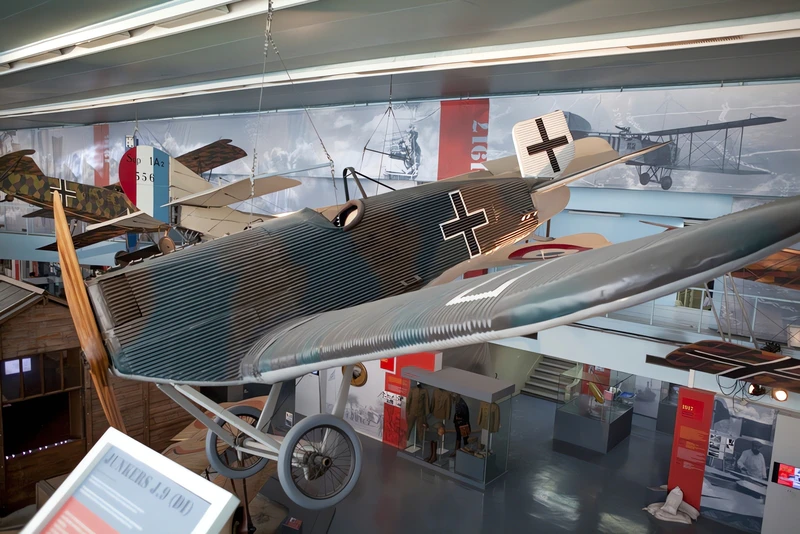
Junkers D.I | |
|---|---|
| Maa | Saksa |
| Rooli | Taistelija |
| Ensimmäinen lento | 17. syyskuuta 1917 |
| Rakennettu | 41 |
Nniiden Junkers D.I (tehdasnimitys J 9) oli yksitasoinen hävittäjälentokone, joka tuotettiin Saksassa ensimmäisen maailmansodan loppupuolella. Prototyyppi, Junkersin yksityinen yritys nimeltä J 7, lensi ensimmäisen kerran 17 syyskuuta 1917, käyden läpi lähes puoli tusinaa yksityiskohtaista muutosta suunnittelussaan testien aikana. Kun se esiteltiin Idfliegille seuraavan vuoden alussa, se osoittautui riittävän vaikuttavaksi, jotta se johti kolmen uuden lentokoneen tilaamiseen kokeita varten. Junkersin tekemät muutokset olivat niin merkittäviä, että yritys nimesi seuraavan esimerkin uudelleen J 9: ksi, joka toimitettiin Idfliegille kolmen tilatun J 7: n sijasta.
Lähde: Junkers D.I Wikipediassa
| Junker J9 D1 Walk Around | |
|---|---|
| Valokuvaaja | Unknow |
| Lokalisointi | Ei tietää |
| Valokuvat | 22 |
Katso myös:
Nniiden Junkers D.I oli uraauurtava lentokone ilmailun historiassa, sillä se oli ensimmäinen täysmetallinen hävittäjä, joka otettiin käyttöön. Sen suunnitteli Hugo Junkers, saksalainen insinööri ja yrittäjä, jolla oli visio luoda lentokoneita, jotka olisivat tehokkaampia ja kestävämpiä kuin perinteiset puusta ja kankaasta valmistetut lentokoneet. Junkers D.I perustui aikaisempaan J 7 -prototyyppiin, joka lensi ensimmäisen kerran syyskuussa 1917 ja johon tehtiin useita muutoksia testiensä aikana. Lopullisessa versiossa, jonka yhtiö nimesi J 9:ksi ja armeijan D.I:ksi, oli yksitasoinen siipi, joka oli valmistettu aallotetusta duralumiinista, kevyestä ja vahvasta metalliseoksesta. Runko oli myös valmistettu duralumiinista, ja teräsputkirunko oli peitetty metallipaneeleilla. Moottori oli vesijäähdytteinen kuusisylinterinen BMW IIIa -rivimoottori, joka tuotti 185 hevosvoimaa. Aseistus koostui kahdesta kiinteästä Spandau-konekivääristä, jotka oli asennettu nokkaan.
Junkers D.I esiteltiin vuonna 1918, lähellä ensimmäisen maailmansodan loppua. Se oli tarkoitettu merivoimien hävittäjäksi, koska se kesti ankaria olosuhteita ja laskeutui epätasaiseen maastoon. Se ei kuitenkaan nähnyt paljon taistelutoimintaa, koska se toimitettiin liian myöhään ja liian vähän. Koneita rakennettiin vain 41 kappaletta, ja suurin osa niistä lähetettiin itärintamalla toimineeseen merivoimien yksikköön aselevon jälkeen. Junkers D.I ei ollut kovin ohjattava, mutta sillä oli suuri nopeus ja katto sekä erinomainen vakaus ja kestävyys. Se oli myös helppo huoltaa ja korjata metallirakenteensa ansiosta. Junkers D.I oli täysmetallisen lentokonesuunnittelun edelläkävijä, josta tuli hallitseva seuraavina vuosikymmeninä. Se vaikutti myöhempien Junkers-mallien, kuten F-13-matkustajakoneen ja J.I-maahyökkäyslentokoneen, kehitykseen. Junkers D.I oli myös yksi ensimmäisistä lentokoneista, joka käytti rakettiavusteista lentoonlähtö- ja tankkaustekniikkaa. Junkers D.I oli merkittävä insinööritaidon ja innovaation saavutus ja virstanpylväs ilmailun historiassa.
Views : 1273


